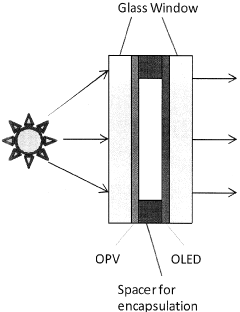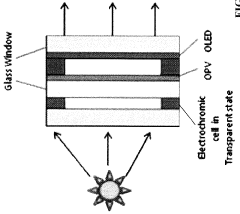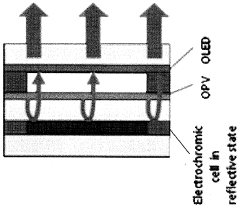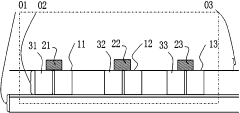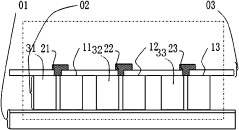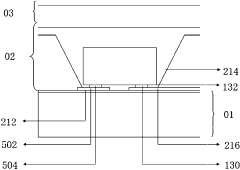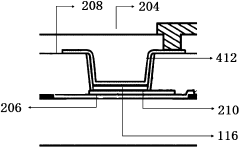ULED and Its Impact on Energy Consumption
JUN 23, 20259 MIN READ
Generate Your Research Report Instantly with AI Agent
Patsnap Eureka helps you evaluate technical feasibility & market potential.
ULED Technology Evolution
ULED (Ultra-Light Emitting Diode) technology has undergone significant evolution since its inception, marking a revolutionary advancement in lighting and display technologies. The journey of ULED began with the development of traditional LED technology, which laid the foundation for more efficient and brighter light sources.
In the early stages, researchers focused on improving the efficiency and brightness of LEDs. This led to the creation of high-brightness LEDs, which found applications in various sectors, including automotive lighting and outdoor displays. However, these early iterations still faced challenges in terms of energy consumption and heat dissipation.
The next major milestone in ULED evolution came with the introduction of organic light-emitting diodes (OLEDs). OLEDs offered advantages such as flexibility and improved color reproduction, but they still struggled with issues related to lifespan and manufacturing costs. This prompted researchers to explore alternative materials and structures to overcome these limitations.
The breakthrough in ULED technology came with the development of quantum dot light-emitting diodes (QLEDs). QLEDs utilize semiconductor nanocrystals to produce highly efficient and vibrant colors. This technology allowed for significant improvements in energy efficiency while maintaining excellent color quality.
As ULED technology progressed, researchers focused on enhancing the electron transport layers and optimizing the quantum dot structure. These advancements led to increased luminous efficiency and reduced power consumption, making ULEDs increasingly attractive for various applications, including displays and lighting solutions.
Recent developments in ULED technology have centered on improving the stability and longevity of the devices. Researchers have made significant strides in developing more robust materials and encapsulation techniques to protect the sensitive quantum dot layers from environmental factors.
The latest generation of ULEDs incorporates advanced color conversion technologies, allowing for even greater energy efficiency and color accuracy. This has been achieved through the use of novel materials and precise control over the quantum dot size and composition.
Looking forward, the evolution of ULED technology is expected to continue with a focus on further reducing energy consumption while improving performance. Researchers are exploring the potential of perovskite-based LEDs and hybrid organic-inorganic structures to push the boundaries of efficiency and color reproduction even further.
As ULED technology continues to mature, it is poised to play a crucial role in addressing global energy consumption concerns. The ongoing evolution of this technology promises to deliver increasingly efficient and versatile lighting and display solutions, contributing to a more sustainable future.
In the early stages, researchers focused on improving the efficiency and brightness of LEDs. This led to the creation of high-brightness LEDs, which found applications in various sectors, including automotive lighting and outdoor displays. However, these early iterations still faced challenges in terms of energy consumption and heat dissipation.
The next major milestone in ULED evolution came with the introduction of organic light-emitting diodes (OLEDs). OLEDs offered advantages such as flexibility and improved color reproduction, but they still struggled with issues related to lifespan and manufacturing costs. This prompted researchers to explore alternative materials and structures to overcome these limitations.
The breakthrough in ULED technology came with the development of quantum dot light-emitting diodes (QLEDs). QLEDs utilize semiconductor nanocrystals to produce highly efficient and vibrant colors. This technology allowed for significant improvements in energy efficiency while maintaining excellent color quality.
As ULED technology progressed, researchers focused on enhancing the electron transport layers and optimizing the quantum dot structure. These advancements led to increased luminous efficiency and reduced power consumption, making ULEDs increasingly attractive for various applications, including displays and lighting solutions.
Recent developments in ULED technology have centered on improving the stability and longevity of the devices. Researchers have made significant strides in developing more robust materials and encapsulation techniques to protect the sensitive quantum dot layers from environmental factors.
The latest generation of ULEDs incorporates advanced color conversion technologies, allowing for even greater energy efficiency and color accuracy. This has been achieved through the use of novel materials and precise control over the quantum dot size and composition.
Looking forward, the evolution of ULED technology is expected to continue with a focus on further reducing energy consumption while improving performance. Researchers are exploring the potential of perovskite-based LEDs and hybrid organic-inorganic structures to push the boundaries of efficiency and color reproduction even further.
As ULED technology continues to mature, it is poised to play a crucial role in addressing global energy consumption concerns. The ongoing evolution of this technology promises to deliver increasingly efficient and versatile lighting and display solutions, contributing to a more sustainable future.
ULED Market Dynamics
The ULED (Ultra-Light Emitting Diode) market has experienced significant growth in recent years, driven by increasing demand for energy-efficient lighting solutions across various industries. As consumers and businesses become more environmentally conscious, the adoption of ULED technology has accelerated, reshaping the lighting industry landscape.
The global ULED market has shown robust expansion, with a compound annual growth rate (CAGR) outpacing traditional lighting technologies. This growth is primarily attributed to the superior energy efficiency of ULED devices, which consume substantially less power compared to conventional LED and incandescent lighting options. The reduced energy consumption not only translates to lower electricity bills for end-users but also contributes to decreased carbon emissions, aligning with global sustainability goals.
Several key factors are influencing the ULED market dynamics. Firstly, government regulations and initiatives promoting energy-efficient lighting solutions have created a favorable environment for ULED adoption. Many countries have implemented policies to phase out energy-intensive lighting technologies, further driving the demand for ULED products.
Secondly, the declining production costs of ULED technology have made it increasingly accessible to a broader range of consumers and industries. As manufacturing processes improve and economies of scale are realized, the price gap between ULED and traditional lighting options continues to narrow, accelerating market penetration.
The commercial and industrial sectors have emerged as significant drivers of ULED market growth. Large-scale facilities, such as warehouses, factories, and office buildings, are increasingly retrofitting their lighting systems with ULED solutions to achieve substantial energy savings and reduce operational costs. The long lifespan of ULED devices further enhances their appeal in these sectors, as it minimizes maintenance requirements and replacement frequencies.
In the residential sector, the ULED market has gained traction due to the growing smart home trend. ULED devices' compatibility with smart lighting systems and their ability to integrate with home automation platforms have made them attractive to tech-savvy consumers seeking both energy efficiency and enhanced control over their living environments.
The automotive industry has also embraced ULED technology, particularly in the electric vehicle (EV) segment. ULED lighting systems in EVs contribute to extended driving ranges by reducing the overall energy consumption of the vehicle, addressing one of the key challenges in EV adoption.
As the ULED market continues to evolve, competition among manufacturers has intensified, leading to rapid technological advancements and product innovations. This competitive landscape has resulted in a diverse range of ULED products catering to various applications and consumer preferences, further stimulating market growth and expanding the technology's reach across different sectors.
The global ULED market has shown robust expansion, with a compound annual growth rate (CAGR) outpacing traditional lighting technologies. This growth is primarily attributed to the superior energy efficiency of ULED devices, which consume substantially less power compared to conventional LED and incandescent lighting options. The reduced energy consumption not only translates to lower electricity bills for end-users but also contributes to decreased carbon emissions, aligning with global sustainability goals.
Several key factors are influencing the ULED market dynamics. Firstly, government regulations and initiatives promoting energy-efficient lighting solutions have created a favorable environment for ULED adoption. Many countries have implemented policies to phase out energy-intensive lighting technologies, further driving the demand for ULED products.
Secondly, the declining production costs of ULED technology have made it increasingly accessible to a broader range of consumers and industries. As manufacturing processes improve and economies of scale are realized, the price gap between ULED and traditional lighting options continues to narrow, accelerating market penetration.
The commercial and industrial sectors have emerged as significant drivers of ULED market growth. Large-scale facilities, such as warehouses, factories, and office buildings, are increasingly retrofitting their lighting systems with ULED solutions to achieve substantial energy savings and reduce operational costs. The long lifespan of ULED devices further enhances their appeal in these sectors, as it minimizes maintenance requirements and replacement frequencies.
In the residential sector, the ULED market has gained traction due to the growing smart home trend. ULED devices' compatibility with smart lighting systems and their ability to integrate with home automation platforms have made them attractive to tech-savvy consumers seeking both energy efficiency and enhanced control over their living environments.
The automotive industry has also embraced ULED technology, particularly in the electric vehicle (EV) segment. ULED lighting systems in EVs contribute to extended driving ranges by reducing the overall energy consumption of the vehicle, addressing one of the key challenges in EV adoption.
As the ULED market continues to evolve, competition among manufacturers has intensified, leading to rapid technological advancements and product innovations. This competitive landscape has resulted in a diverse range of ULED products catering to various applications and consumer preferences, further stimulating market growth and expanding the technology's reach across different sectors.
ULED Technical Challenges
Ultra-Light Emitting Diodes (ULEDs) represent a significant advancement in lighting technology, promising substantial reductions in energy consumption. However, the development and widespread adoption of ULEDs face several technical challenges that need to be addressed.
One of the primary challenges is achieving high efficiency at low current densities. ULEDs are designed to operate at extremely low power levels, but maintaining high quantum efficiency under these conditions is difficult. The internal quantum efficiency tends to decrease at low current densities due to non-radiative recombination processes, which become more dominant. Overcoming this efficiency droop requires innovative approaches in material science and device architecture.
Another significant challenge lies in the thermal management of ULEDs. Although they operate at lower power levels compared to conventional LEDs, the concentrated nature of the light emission can still lead to localized heating. This thermal issue can affect the device's long-term stability and performance. Developing effective heat dissipation mechanisms without compromising the ultra-thin profile of ULEDs is crucial.
The manufacturing process for ULEDs also presents technical hurdles. Producing ultra-thin, uniform layers of semiconductor materials with precise control over doping levels and interfaces is extremely challenging. Advanced epitaxial growth techniques and novel fabrication methods need to be developed to ensure consistent quality and performance across large-scale production.
Color rendering and spectral tuning pose additional challenges for ULEDs. Achieving a wide color gamut and high color rendering index (CRI) while maintaining ultra-low power consumption requires careful engineering of the emissive layers and phosphor materials. Balancing these factors without sacrificing efficiency is a complex task that demands innovative material designs and optical engineering solutions.
Lastly, the integration of ULEDs into existing lighting systems and infrastructure presents both technical and practical challenges. Developing compatible drivers and control systems that can efficiently manage the ultra-low power requirements of ULEDs while providing smooth dimming and color control is essential. Additionally, ensuring that ULEDs can meet various industry standards and regulations for lighting quality, safety, and electromagnetic compatibility adds another layer of complexity to their development and implementation.
Addressing these technical challenges is crucial for realizing the full potential of ULEDs in reducing energy consumption. Overcoming these hurdles will require collaborative efforts across multiple disciplines, including materials science, device physics, thermal engineering, and manufacturing technology. As research progresses, innovative solutions to these challenges will pave the way for ULEDs to revolutionize energy-efficient lighting across various applications.
One of the primary challenges is achieving high efficiency at low current densities. ULEDs are designed to operate at extremely low power levels, but maintaining high quantum efficiency under these conditions is difficult. The internal quantum efficiency tends to decrease at low current densities due to non-radiative recombination processes, which become more dominant. Overcoming this efficiency droop requires innovative approaches in material science and device architecture.
Another significant challenge lies in the thermal management of ULEDs. Although they operate at lower power levels compared to conventional LEDs, the concentrated nature of the light emission can still lead to localized heating. This thermal issue can affect the device's long-term stability and performance. Developing effective heat dissipation mechanisms without compromising the ultra-thin profile of ULEDs is crucial.
The manufacturing process for ULEDs also presents technical hurdles. Producing ultra-thin, uniform layers of semiconductor materials with precise control over doping levels and interfaces is extremely challenging. Advanced epitaxial growth techniques and novel fabrication methods need to be developed to ensure consistent quality and performance across large-scale production.
Color rendering and spectral tuning pose additional challenges for ULEDs. Achieving a wide color gamut and high color rendering index (CRI) while maintaining ultra-low power consumption requires careful engineering of the emissive layers and phosphor materials. Balancing these factors without sacrificing efficiency is a complex task that demands innovative material designs and optical engineering solutions.
Lastly, the integration of ULEDs into existing lighting systems and infrastructure presents both technical and practical challenges. Developing compatible drivers and control systems that can efficiently manage the ultra-low power requirements of ULEDs while providing smooth dimming and color control is essential. Additionally, ensuring that ULEDs can meet various industry standards and regulations for lighting quality, safety, and electromagnetic compatibility adds another layer of complexity to their development and implementation.
Addressing these technical challenges is crucial for realizing the full potential of ULEDs in reducing energy consumption. Overcoming these hurdles will require collaborative efforts across multiple disciplines, including materials science, device physics, thermal engineering, and manufacturing technology. As research progresses, innovative solutions to these challenges will pave the way for ULEDs to revolutionize energy-efficient lighting across various applications.
ULED Energy Efficiency
01 ULED structure for improved energy efficiency
Ultra Light Emitting Diodes (ULEDs) are designed with advanced structures to enhance energy efficiency. These structures may include optimized quantum well layers, improved electron blocking layers, and novel electrode designs. Such improvements in ULED structure contribute to reduced energy consumption while maintaining or improving light output.- Energy-efficient ULED design: Ultra Light Emitting Diodes (ULEDs) are designed with advanced structures and materials to maximize energy efficiency. These designs often incorporate novel semiconductor layers, improved electron-hole recombination, and enhanced light extraction techniques to reduce energy consumption while maintaining high brightness levels.
- Thermal management for ULED energy optimization: Effective thermal management is crucial for optimizing ULED energy consumption. Advanced heat dissipation techniques, such as improved substrate materials, thermal interfaces, and cooling systems, are implemented to reduce energy loss through heat and maintain ULED efficiency over extended periods of operation.
- ULED driver circuit optimization: Specialized driver circuits are developed to minimize energy losses in ULED operation. These circuits often incorporate advanced power management techniques, precise current control, and adaptive dimming capabilities to reduce overall energy consumption while maintaining optimal ULED performance across various operating conditions.
- ULED phosphor and color conversion efficiency: Improvements in phosphor materials and color conversion techniques contribute to enhanced energy efficiency in ULEDs. Advanced phosphors with higher quantum yields and optimized color conversion layers help reduce energy losses during the light emission process, resulting in lower overall energy consumption for a given light output.
- ULED array and panel design for energy efficiency: Innovative ULED array and panel designs focus on optimizing energy consumption in large-scale applications. These designs often incorporate advanced optical arrangements, intelligent control systems, and energy-efficient driving schemes to minimize power usage while maintaining high-quality illumination across the entire ULED array or panel.
02 Thermal management in ULEDs
Effective thermal management is crucial for ULED energy efficiency. Advanced heat dissipation techniques, such as improved substrate materials, thermal interface materials, and innovative packaging designs, help to reduce energy loss through heat. This results in lower overall energy consumption and improved ULED performance.Expand Specific Solutions03 ULED driver circuits for energy optimization
Specialized driver circuits are developed for ULEDs to optimize energy consumption. These circuits may include advanced power management features, precise current control, and adaptive dimming capabilities. By efficiently regulating power supply and current flow, these driver circuits significantly reduce energy waste in ULED systems.Expand Specific Solutions04 Material innovations for ULED efficiency
Novel materials are being developed and utilized in ULED manufacturing to enhance energy efficiency. These may include advanced semiconductor materials, improved phosphors for color conversion, and innovative electrode materials. Such material innovations contribute to higher light output efficiency and lower energy consumption in ULEDs.Expand Specific Solutions05 ULED array design for energy-efficient lighting
Optimized ULED array designs are implemented to maximize energy efficiency in lighting applications. These designs consider factors such as ULED spacing, arrangement patterns, and light distribution. By optimizing the array configuration, overall system energy consumption can be reduced while maintaining desired illumination levels.Expand Specific Solutions
ULED Industry Leaders
The ULED (Ultra-Light Emitting Diode) technology market is in its early growth stage, with significant potential for energy consumption reduction in display applications. The market size is expanding rapidly, driven by increasing demand for energy-efficient displays across various sectors. While the technology is still evolving, several key players are making substantial advancements. Companies like Lumileds LLC, Seoul Semiconductor Co., Ltd., and Samsung Electronics Co., Ltd. are at the forefront of ULED development, focusing on improving efficiency and performance. Other notable contributors include Huawei Technologies Co., Ltd. and Intel Corp., who are integrating ULED technology into their product ecosystems. Academic institutions such as Ghent University and Boston University are also contributing to the research and development of ULED technology, indicating a collaborative industry-academia approach to innovation in this field.
Ghent University
Technical Solution: Researchers at Ghent University have been working on improving ULED technology through the development of novel materials and manufacturing processes. Their approach focuses on enhancing the efficiency of light-emitting diodes at the nanoscale level. By manipulating the structure of semiconductor materials, they aim to increase the internal quantum efficiency of LEDs, resulting in higher light output with lower power consumption. The university's research also explores the use of advanced phosphors and quantum dots to improve color rendering and expand the color gamut of ULED displays. Additionally, they are investigating new driver circuits and control algorithms to optimize power management in ULED systems.
Strengths: Cutting-edge research in materials science and potential for significant efficiency improvements. Weaknesses: Research is still in early stages and may take time to commercialize.
Seoul Semiconductor Co., Ltd.
Technical Solution: Seoul Semiconductor has developed its proprietary WICOP (Wafer Level Integrated Chip on PCB) technology, which is a key component in their ULED solutions. This technology allows for the creation of ultra-thin LED packages without the need for traditional packaging elements like wire bonding or metal frames. By eliminating these components, WICOP technology reduces thermal resistance and improves light extraction efficiency, leading to better performance and lower energy consumption. Seoul Semiconductor has also focused on developing high-efficiency phosphors and advanced optical designs to further enhance the energy efficiency of their ULED products. The company's ULED solutions have been implemented in various applications, including automotive lighting, display backlighting, and general illumination.
Strengths: Innovative packaging technology, improved thermal management, and versatile applications. Weaknesses: May face competition from established players in specific market segments.
ULED Core Innovations
Solar-powered lighting module
PatentWO2010141580A2
Innovation
- A solar-powered lighting module incorporating a solar cell for energy generation, a lithium-ion battery for storage, and an organic light-emitting diode (OLED) for lighting, which can be integrated into building interfaces like windows to provide efficient, off-grid lighting while reducing energy consumption.
ULED/OLED integrated light emitting body for display
PatentActiveCN108039359A
Innovation
- Using ULED and OLED combined light emitters, by forming an epitaxial barrier crystal film layer and pixel points on the substrate, using micro ULED and OLED to connect in parallel respectively, controlling the combination of micro inorganic light-emitting diodes and organic light-emitting diodes, and using gallium nitride materials to improve Light efficiency, and achieve efficient electrical connection through the electrical interface matrix layer and LED controller.
ULED Environmental Impact
The environmental impact of Ultra-Light Emitting Diodes (ULEDs) is a crucial aspect to consider as this technology gains prominence in the lighting industry. ULEDs offer significant advantages in terms of energy efficiency, potentially reducing electricity consumption and associated greenhouse gas emissions.
One of the primary environmental benefits of ULEDs is their low power consumption. Compared to traditional lighting technologies, ULEDs can achieve the same level of illumination while using substantially less energy. This reduction in energy usage translates directly to lower carbon emissions from power generation, particularly in regions where fossil fuels remain a significant part of the energy mix.
The longevity of ULEDs also contributes to their positive environmental impact. With lifespans often exceeding 50,000 hours, these devices require less frequent replacement than conventional lighting solutions. This extended lifespan reduces the demand for raw materials and energy required for manufacturing replacement units, thereby minimizing the overall environmental footprint of lighting systems over time.
Furthermore, ULEDs contain no mercury, unlike fluorescent lamps, which pose environmental risks when improperly disposed of. The absence of mercury eliminates the need for special handling and disposal procedures, reducing the potential for harmful substances to enter ecosystems.
The compact size of ULEDs allows for more efficient packaging and transportation, potentially reducing the carbon footprint associated with distribution. Additionally, their durability means fewer breakages during shipping and installation, further minimizing waste.
However, it is important to consider the full lifecycle impact of ULEDs. The production process involves the use of rare earth elements and other materials that may have environmental implications during extraction and processing. Ensuring responsible sourcing and developing efficient recycling methods for these materials are crucial steps in maximizing the environmental benefits of ULED technology.
The potential for light pollution is another environmental consideration. While ULEDs can be designed to minimize light scatter, their increased efficiency may lead to more widespread use, potentially exacerbating light pollution issues if not properly managed. Implementing smart lighting systems and appropriate regulations can help mitigate this concern.
In conclusion, ULEDs offer significant environmental advantages, primarily through reduced energy consumption and longer lifespans. However, a comprehensive approach to their implementation, including responsible manufacturing, efficient recycling, and thoughtful deployment, is necessary to fully realize their potential for positive environmental impact.
One of the primary environmental benefits of ULEDs is their low power consumption. Compared to traditional lighting technologies, ULEDs can achieve the same level of illumination while using substantially less energy. This reduction in energy usage translates directly to lower carbon emissions from power generation, particularly in regions where fossil fuels remain a significant part of the energy mix.
The longevity of ULEDs also contributes to their positive environmental impact. With lifespans often exceeding 50,000 hours, these devices require less frequent replacement than conventional lighting solutions. This extended lifespan reduces the demand for raw materials and energy required for manufacturing replacement units, thereby minimizing the overall environmental footprint of lighting systems over time.
Furthermore, ULEDs contain no mercury, unlike fluorescent lamps, which pose environmental risks when improperly disposed of. The absence of mercury eliminates the need for special handling and disposal procedures, reducing the potential for harmful substances to enter ecosystems.
The compact size of ULEDs allows for more efficient packaging and transportation, potentially reducing the carbon footprint associated with distribution. Additionally, their durability means fewer breakages during shipping and installation, further minimizing waste.
However, it is important to consider the full lifecycle impact of ULEDs. The production process involves the use of rare earth elements and other materials that may have environmental implications during extraction and processing. Ensuring responsible sourcing and developing efficient recycling methods for these materials are crucial steps in maximizing the environmental benefits of ULED technology.
The potential for light pollution is another environmental consideration. While ULEDs can be designed to minimize light scatter, their increased efficiency may lead to more widespread use, potentially exacerbating light pollution issues if not properly managed. Implementing smart lighting systems and appropriate regulations can help mitigate this concern.
In conclusion, ULEDs offer significant environmental advantages, primarily through reduced energy consumption and longer lifespans. However, a comprehensive approach to their implementation, including responsible manufacturing, efficient recycling, and thoughtful deployment, is necessary to fully realize their potential for positive environmental impact.
ULED Regulatory Landscape
The regulatory landscape for Ultra-Light Emitting Diodes (ULEDs) is rapidly evolving as governments and international organizations recognize the potential of this technology to significantly reduce energy consumption. Many countries are implementing or considering regulations to promote the adoption of ULED technology and set standards for energy efficiency.
In the United States, the Department of Energy (DOE) has been at the forefront of ULED regulation. The Energy Policy and Conservation Act (EPCA) provides the framework for energy efficiency standards, which now include provisions for ULED technology. The DOE has proposed new rules that would require higher luminous efficacy standards, potentially accelerating the transition from traditional LEDs to ULEDs.
The European Union has also been proactive in regulating ULED technology. The Ecodesign Directive, which sets mandatory energy efficiency requirements for products sold in the EU, is being updated to include specific provisions for ULEDs. These regulations aim to phase out less efficient lighting technologies and promote the adoption of ULEDs across member states.
In Asia, countries like Japan and South Korea are leading the way in ULED regulation. Japan's Top Runner Program, which sets energy efficiency standards based on the most efficient products in the market, now includes ULEDs. This approach encourages manufacturers to continually improve their products to meet or exceed the highest efficiency standards.
International organizations are also playing a crucial role in shaping the ULED regulatory landscape. The International Electrotechnical Commission (IEC) is developing global standards for ULED performance and safety. These standards will help harmonize regulations across different countries and facilitate international trade in ULED products.
Many countries are implementing incentive programs to encourage the adoption of ULED technology. These include tax credits for manufacturers, rebates for consumers, and government procurement policies that prioritize ULED products. Such initiatives are designed to accelerate market penetration and drive down costs through economies of scale.
As ULED technology continues to advance, regulators are faced with the challenge of keeping pace with innovation. Adaptive regulatory frameworks are being developed to allow for rapid updates to standards as the technology evolves. This approach aims to strike a balance between promoting innovation and ensuring energy efficiency goals are met.
In the United States, the Department of Energy (DOE) has been at the forefront of ULED regulation. The Energy Policy and Conservation Act (EPCA) provides the framework for energy efficiency standards, which now include provisions for ULED technology. The DOE has proposed new rules that would require higher luminous efficacy standards, potentially accelerating the transition from traditional LEDs to ULEDs.
The European Union has also been proactive in regulating ULED technology. The Ecodesign Directive, which sets mandatory energy efficiency requirements for products sold in the EU, is being updated to include specific provisions for ULEDs. These regulations aim to phase out less efficient lighting technologies and promote the adoption of ULEDs across member states.
In Asia, countries like Japan and South Korea are leading the way in ULED regulation. Japan's Top Runner Program, which sets energy efficiency standards based on the most efficient products in the market, now includes ULEDs. This approach encourages manufacturers to continually improve their products to meet or exceed the highest efficiency standards.
International organizations are also playing a crucial role in shaping the ULED regulatory landscape. The International Electrotechnical Commission (IEC) is developing global standards for ULED performance and safety. These standards will help harmonize regulations across different countries and facilitate international trade in ULED products.
Many countries are implementing incentive programs to encourage the adoption of ULED technology. These include tax credits for manufacturers, rebates for consumers, and government procurement policies that prioritize ULED products. Such initiatives are designed to accelerate market penetration and drive down costs through economies of scale.
As ULED technology continues to advance, regulators are faced with the challenge of keeping pace with innovation. Adaptive regulatory frameworks are being developed to allow for rapid updates to standards as the technology evolves. This approach aims to strike a balance between promoting innovation and ensuring energy efficiency goals are met.
Unlock deeper insights with Patsnap Eureka Quick Research — get a full tech report to explore trends and direct your research. Try now!
Generate Your Research Report Instantly with AI Agent
Supercharge your innovation with Patsnap Eureka AI Agent Platform!

